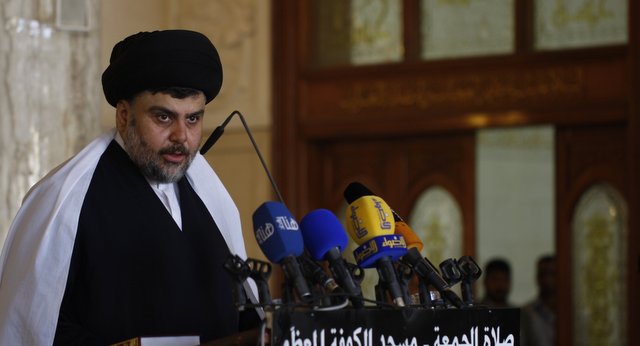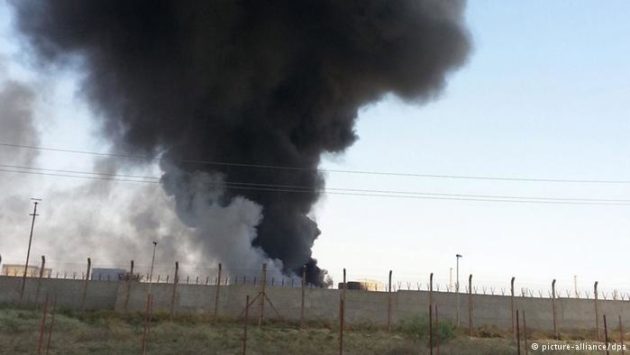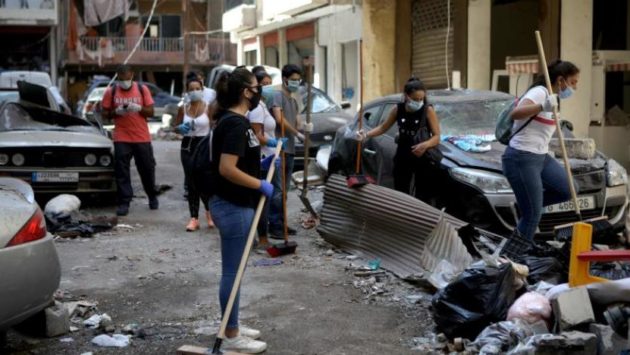Rethinking Sadr: From Firebrand to Iraqi Statesman?
By: RENAD MANSOUR, MICHAEL DAVID CLARK
Source: carnegieendowment
Muqtada al-Sadr, once labeled “the most dangerous man in Iraq,” now offers a potential solution to Iraq’s troubles. The scion of an influential religious family who rose by inheriting his father’s movement and building a militia after the United States toppled former Iraqi president Saddam Hussein in 2003, he enjoys significant grassroots support within the Shiaa community. In the period after 2003, he was a divisive figure often associated with sectarian violence. But in the past few years, Sadr has re-calibrated his politics and adopted an Iraqi-first approach that transcends sub-national sectarian interests and could in fact help to heal the rifts in Iraq.
Popular perception of Sadr and his movement remains based on a somewhat flawed view of his role in the years following Saddam’s overthrow, when he was typically identified as a Shia warlord with little regard for national institutions. His behavior at the height of violence in Iraq, around 2006–2008, certainly forms an important and troublesome part of his legacy, but to write Sadr off as just another Shiaa militia leader not only misrepresents his history but also disregards the dynamic nature of this young leader.
INHERITING AND PRESERVING LEGITIMACY
The murder in 1999 of Sadr’s older brothers and their father, the revered grand ayatollah Mohammed Mohammed Sadeq al-Sadr, left a young and inexperienced Muqtada as the de facto leader of the Sadrist Movement, a powerful politico-religious trend within Iraqi Shia Islam. However, Sadr was not alone. He was aided by a cadre of his father’s advisors, such as Qais al-Khazali, and the de jure leader Ayatollah Kazem al-Haeri in faraway Qom, Iran. By focusing on social and religious duties while explicitly avoiding any confrontation with the regime, not only did Sadr survive the Baath Party’s continuing purges of Shiaa leaders, but he developed the political skills and affiliations that would serve him so well in a post-Saddam Iraq.
Unlike almost every other current Iraqi leader, whether Shia or Sunni, Sadr was therefore able to remain in Iraq throughout the Saddam era. It is now a constant trope in Sadrist discourse that the returning leaders of post-2003 Iraq had not shared in the suffering of the people and are not legitimate representatives of Iraqis. Instead they are tainted by their years of exile, whether in Iran or the West. Sadr has capitalized on this discrepancy to portray himself as a genuine independent and a man of the people.
MILITARIZING SECTARIANISM AFTER 2003
The downfall of Saddam and his clique allies from Tikrit and other Sunni Arab areas sparked a major shift in power relations. Previously oppressed Shia factions burst onto the political scene and took control of the state apparatus, displacing the previous Sunni Arab leadership in a sometimes savagely violent fashion.
The Sadrists were part of this shift and they helped to stoke early sectarian tension by encouraging the wholesale dismissal of officials with links, real or perceived, to Saddam. Disregarding Sunni Arab protests, Sadr’s followers worked to accelerate the purges of former members of Saddam’s ruling Baath Party in the so-called “de-Baathification process.” They have continued to do so despite the negative impact on Iraqi reconciliation and sectarian relations. Even in recent years, as Sunni grievances resurged in response to Nouri al-Maliki’s polarizing 2006–2014 premiership, the Sadrist movement has repeatedly refused to relent on de-Baathification laws.
Major fighting rocked Iraq in 2006–2008. At the height of the war in late 2006, Sadr’s militia organization, which was known as Jaish al-Mahdi or the Mahdi Army, waged a cruel war against Sunni militias, often resorting to horrific methods to terrorize and demoralize its opposition. Reports abound of Mahdi Army death squads that murdered Sunnis through torture, including with electric drills.
Sadr maintains that some of the more violent attacks were carried out by “splinter elements.” Iranian support for certain elements within the Mahdi Army, in particular Khazali’s special factions, had undermined Sadr’s control. As early as September 2006, increasingly empowered local militiamen were indeed going rogue. Sadr now asserts that those Sadrists responsible for terrorism, murder, and criminal activity during the 2006–2008 civil war were mostly the Khazali-led factions that eventually broke off and became the Iranian-backed militia Asaib Ahl al-Haq (League of the Righteous).
THE NEW SADR: SEEKING BROADER ALLIANCES
Regardless of how to assign blame for the Mahdi Army’s abuses in the 2006–2008 period, Sadr’s policies in this period were certainly influenced by sectarian calculations and they contributed greatly to Sunni resentment and Iraq’s descent into civil war. So why, then, is Sadr a positive influence on Iraq’s polity at present?
The Sadrists have always sought to wrap themselves in the Iraqi flag, but recently they have also begun to act the part of a national force. Partly, this is due to Sadr’s frustration with rival Iranian-backed Shia factions in Iraq. Sadr rejects Tehran’s influence over Iraq’s prime minister, a post reserved for Shia candidates. In particular, he had very difficult relations with Maliki, who held the post between 2006 and 2014 and who led a crackdown on the Mahdi Army in 2008, forcing it to disband.
Sadr’s hostility for Maliki has created opportunities for cross-sectarian collaboration. For example, he voiced support for the Sunni protesters who began airing grievances against Maliki in 2011. In 2012, Sadr forged a parliamentary alliance with Kurdish leader Massoud Barzani and the Sunni-favored centrist politician Ayad Allawi to motion for a no-confidence vote against Maliki. Had Maliki been forced to resign, that could possibly have prevented Iraq’s current chaos. However, Iran used its relationship with the Patriotic Union of Kurdistan leader Jalal Talabani, who was then president of Iraq, to keep the premier in place for two more years.
The Sadrists have also committed themselves to re-empowering Iraq’s local political institutions and parliament, all sidelined by Maliki’s centralized rule. This can be seen in their repeated demands for the relocation of bodies such as the Integrity Commission (which monitors cases of corruption and extra-legal activity) and the Justice and Accountability Commission (which organizes the de-Baathification process) from the Prime Minister’s Office to the House of Representatives. For the Sadrists, those directly elected by the people should handle such important portfolios, rather than the executive, as has been the case under Maliki.
A NEW ROLE FOR SADRIST MILITIAS
With the rising influence of the Sunni-extremist group known as the Islamic Statein Sunni Arab areas of Iraq, Sadr has reinstituted an active militia force, six years after disbanding the Mahdi Army. While the old name referenced Shia millennialism, he now chose to call the armed wing of the Sadrist movement Saraya al-Salam, the Peace Companies. The change from an allusion to Shia theology to a nonsectarian sobriquet is representative of the shift that the Sadrist movement is undergoing.
The Peace Companies is obviously a Shia force and it does work to defend its own religious sect, for example by helping to break the Islamic State’s siege of the Turcoman Shia town of Amerli this August. But unlike during the 2006–2008 violence, it now also fights alongside Sunni tribes and Christians. In November 2014, 3,000 Peace Companies fighters reportedly came to the aid of the Albu Nimr tribe in Hit and Haditha to repel the Islamic State onslaught. The Peace Companies has also sought to symbolically demonstrate its nationalist credentials by broadcasting images of fighters removing sectarian flags in favor of the Iraqi flag.
A BORN-AGAIN NATIONALIST
While Sadr was always known for Iraqi-nationalist rhetoric, it wasn’t necessarily matched by the behavior of his forces on the ground. But in recent years the Sadrist Movement has displayed a relentless commitment to Iraq’s national sovereignty vis-à-vis external influences, particularly Iran and the United States and more recently the Islamic State. Sadr maintains that “the destiny of Iraqis should be decided by Iraqis themselves.” After the 2014 national elections, Sadrists leaders declared that their success at the polls was “a blow to the countries of the region that seek to weaken Iraq through the instigations of sectarian strife in order to include it in their empires.”
By focusing blame for Iraq’s woes on outside actors and supporting national-level institutions, Sadr attempts to foster Iraqi-first solidarity. He continuously calls on the Iraqi Security Forces (ISF) to play a greater role in liberating Iraqi territory from Islamic State fighters.
This represents another change from previous policies. Sadr formerly had very poor relations with the ISF, partly due to his perception that it served as a tool of Maliki and other pro-Iranian Shia factions. In 2006–2008, for example, the Mahdi Army repeatedly fought ISF troops loyal to the Badr Corps, an Iranian-backed militia against which Sadr has long held a grudge. But now, the Peace Companies participate in joint operations with the ISF against the Islamic State, for example in Tikrit. Once his rival Maliki was deposed, Sadr quickly grew to appreciate the importance of a strong and centralized ISF force, both to roll back the Islamic State and to counter the proliferation of Iranian-oriented Shia militias that question Baghdad’s sovereignty.
The opposition to foreign interference in Iraq may seem self-serving, but Sadr has insisted that the same principle should apply elsewhere too. Even though he once received support from Lebanon’s Hezbollah as he built his militia after the fall of Saddam, Sadr now criticizes groups who intervene in other countries for pan-Shia ideological reasons or at Iran’s behest. A senior Sadrist leader surprised some by bluntly stating that Hezbollah has “now killed more Syrians than Israelis” by fighting on the side of Syrian President Bashar al-Assad in Syria. Sadr himself hasargued that “what is happening in Syria is an internal issue and no one is entitled to interfere.” To promote his Iraq-first vision, Sadr now advocates “a regional charter between Iraq and other states, based on general common interests and without interference in internal affairs.”
PART OF THE SOLUTION FOR IRAQ?
Is the Sadr model then a potential solution to the sectarian strife that mars Iraq, Syria, and the rest of the neighborhood? Members of his movement certainly have been part of the problem, for example by pursuing de-Baathification in a vengeful and sectarian fashion. Sadr himself has a troubled past and occasionally lapses into extremist rhetoric even today.
However, by arguing against Iraqis being drawn into cross-border sectarian struggles, Sadr has positioned himself as an important voice of reason within the Shia community that dominates Iraq. The Iraqi-first mindset now promoted by the Sadrists is crucial for Iraq’s continued survival, as secessionist sentiments grow not only among Sunni Arabs and Kurds, but also among the Shia. While both Iraqis and the international community used to laugh at the idea of Sadrists in government, today it may be a precondition for Iraq’s return to stability.




